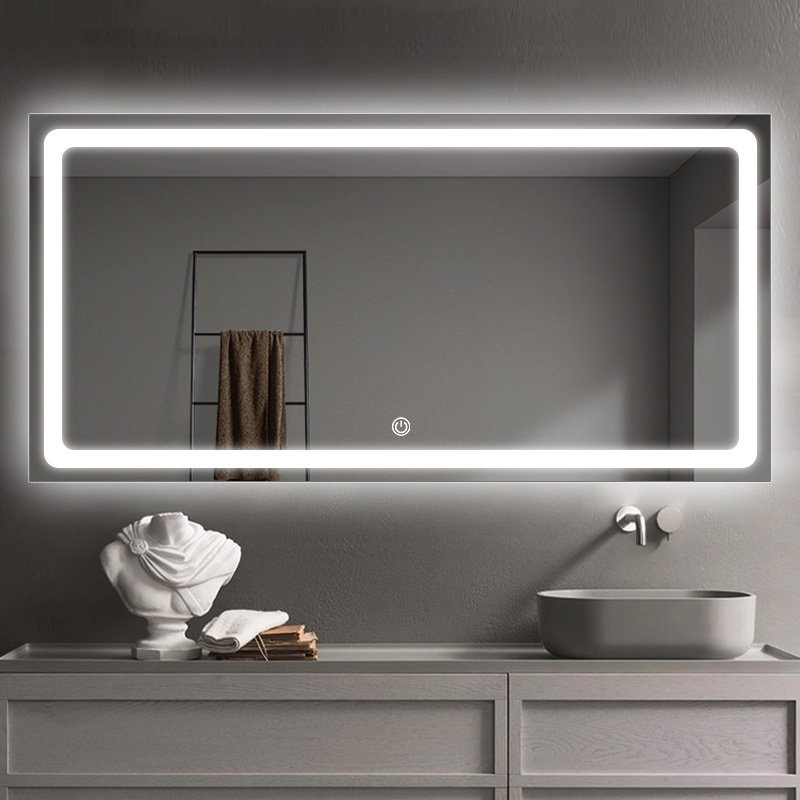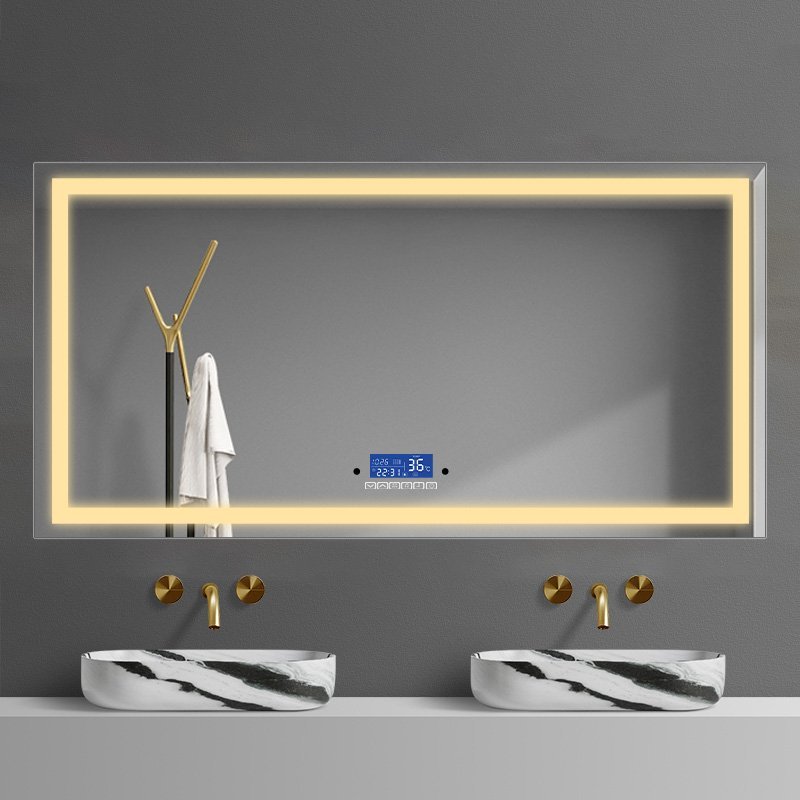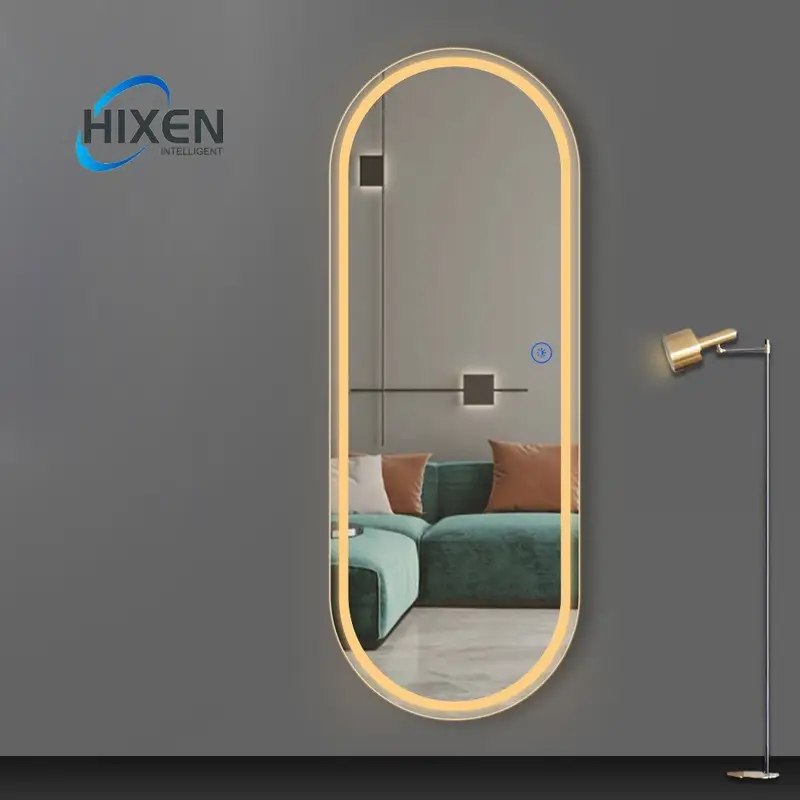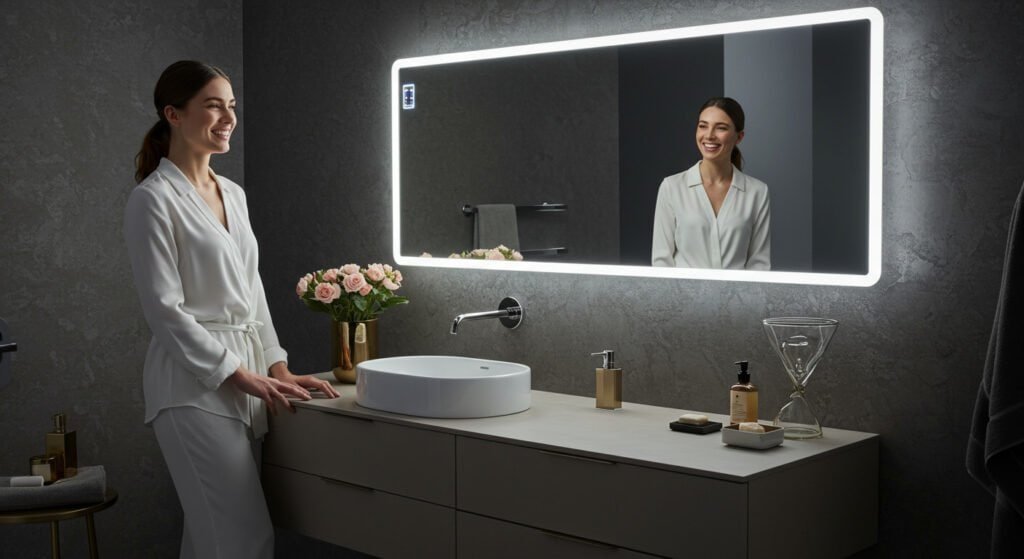|
Mendapatkan anda Trinity Audio pemain siap ...
|
Poor mirror positioning may disrupt sleep quality and create uncomfortable energy in your personal sanctuary. Jadi, where to put mirror in bedroom?
The ideal bedroom mirror placement depends on your specific needs—typically across from windows to reflect natural light, on closet doors for practicality, or above dressers for daily grooming. Avoid placing mirrors directly facing the bed, as this disrupts sleep quality and peaceful energy according to many design philosophies.
So where should you put mirrors for the best results? And how can you use mirrors to enhance the look and feel of your bedroom?

Strategic Mirror Placement for Visual Expansion
Di samping itu, using mirrors with built-in lights can help brighten up a room, making it feel larger and more open. Positioning a mirror in an area where it reflects natural light from a window can also help to increase the feeling of space since it effectively doubles the amount of light in the room.
Where you put mirrors in a bedroom can help to create space visually. Consider doing a bedroom with mirror wall treatment for a big impact on how large the room feels. LED light mirror vanity works miracles in a small bedroom because it bounces light and you get reflection in one. For those looking for a really bold move, some designers are doing mirror above bed on ceiling, where you actually have a mirrored ceiling over the bed. As you might expect, this isn’t for the faint of heart; it’s something you’d want to think about carefully due to both the look and the practical implications.
If you do something in an angled or tight space, you can use lighted makeup mirror on side walls. By reflecting two sides of a room butted into each other, you can create the effect of the corners being pushed out which is a really neat trick. In a small bedroom, a professional interior designer might take a bathroom vanity mirror and light and put it up on the wall in the bedroom, magnify it x 10, and forget about the LED light bars in the bedroom.
Popular Types of Bedroom Mirrors and Their Ideal Locations
Different types of mirrors have specific jobs in a bedroom. Each type of mirror has an optimal place to use to get the best look and use. Where to put mirrors in a bedroom:
- Full length mirrors are best on closet doors or on the back of the door.
- Vanity mirror with LED lights belongs on a dressing table or above a long dresser.
- Decorative mirrors are great for accent walls, and can be a point of art.
LED mirrors have changed bedroom mirror options forever. A lighted vanity mirror for the bathroom in the master bedroom is great because it gives you good light for grooming and looks cool too. If you’re a woman and you do your makeup in your bedroom, get a light up vanity mirror that is at eye level when you’re seated. When you choose mirror design in your bedroom, pay attention to how the frame style of the mirror complements your furniture and décor.
LED bathroom mirrors for a bedroom make sense when you have a bedroom with an en-suite and you need practical light and a cool look. If you have a bathroom where a mirror might steam up, a light mirror with anti-fog is useful. A lighted wall mirror in a bathroom bedroom that spans an entire wall works a lot better, if it doesn’t close everything in. The hot new trend in dressing mirror designs in the bedroom includes LED lighting with an adjustable color temperature to simulate various environments.

Where Not to Put Mirror in Bedroom?
Certain mirror placements can create uncomfortable energy or practical issues in bedrooms, making them locations to avoid despite aesthetic appeal. Avoid placing mirrors directly facing the bed, directly opposite doorways where they might startle you, or in positions that create awkward reflections of private areas. Mirrors reflecting clutter or work areas can psychologically multiply stress.
Some interior designers caution against positioning bathroom vanity mirrors in bedroom locations where they might directly reflect the bed. This is said to create a sensation of being watched while trying to rest. Juga, never position LED bathroom mirror installations so they cast a glaring light on TV screens or computer monitors.
Mirrors in the bedroom should not reflect negative things, such as a cluttered storage area or an unpleasant view. You don’t want a vanity mirror to reflect back anything that could be considered “in the negative,” including a messy, chaotic room. Glass mirror installations become problematic when positioned where they might create confusing reflections during middle-of-the-night trips to the bathroom. Experts advise against placing any backlit mirror where the lighting can disturb sleep patterns or cast unsettling shadows.
Some designers will also advise against having lighted makeup mirror fixtures in locations where they are reflecting directly into bed. The feeling of surveillance when trying to sleep is one reason. Then there is also the psychological aspect of light reflection. The old wives’ tale is that you shouldn’t have a mirror facing your bed because it will keep you awake.
How High Should a Mirror Be in Bedroom?
The ideal height for bedroom mirrors depends on what they’re reflecting and who’s using them. For dressing mirrors, center the mirror’s reflection at the eye level of the person mostly to be seen in it (often 57-65 inci dari lantai). For mirrors hung above furniture, try to keep the bottom edge of the frame approximately 4-6 inches above the top of the taller piece of furniture and maintain proportional spacing.
If you’re putting in a Led Light Mirror vanity combination or similar, consider the seated as well as the standing view if it’s primarily a makeup mirror. Led bathroom vanity mirrors should typically have their centers set at 64 inches from the floor if they’re going to be used while standing.
When considering the right height for a light up vanity mirror in a bedroom, take into consideration ceiling height and room proportions. Professional lighted mirror installers suggest that when putting in a lighted makeup mirror around the vanity area of a bedroom, they should be installed to eliminate shadows on your face when performing tasks.
In children’s rooms, think about mounting options that might be adjustable for height or lower because they can adjust them as they get taller. Wall mirror with lights work best when placed to bounce light around the space. When you’re mounting a modern lighted mirrors for bathrooms in a bedroom, try to have it relate to other elements in the room for a more aesthetically pleasing appearance.

What Is the Superstition About Mirrors in Bedrooms?
Superstitions about mirrors in the bedroom go back centuries and across cultures, often cautioning about where to place them to avoid supernatural problems. In many cultural beliefs, mirrors in bedrooms can trap out-of-body souls, attract malevolent spiritual entities, or create gateways to other worlds like a terrible sci-fi film. In some traditions, they recommend covering mirrors at night, especially during times of grief or mourning.
Fear of where to put a mirror in a bedroom goes back to the idea in many cultures and dating back centuries that reflective surfaces can trap or hold part of the soul. Don’t even get me started on where to put a bathroom light mirror near a bed in a bedroom. The water energy of the bathroom combined with reflective stuff makes it an active, restive place.
Growing up, I heard tales of old wives’ superstitions. You weren’t supposed to have a mirror in front of the bed that, when you woke up, you could see yourself in because that would reflect your soul. I was also told by grandparents and parents that it wasn’t good for children to be able to see a mirror when they were sleeping, so you needed to put lighted makeup mirror fixtures in a different part of the room.
The belief systems around mirrors in bedroom spaces have influenced architectural decisions across various cultures, with some historical bedroom designs specifically avoiding mirror placement entirely. While modern understanding views these concerns as superstition, psychological research suggests our brains process reflections differently during semi-conscious states, potentially explaining why many people instinctively feel uncomfortable with bedroom with mirror wall designs that create reflections visible from bed positions.
Why Is the Mirror Not Good in the Bedroom?
Despite their practical benefits, mirrors face criticism from various design philosophies due to concerns about energy disruption and psychological impact. Some experts believe bedroom mirrors can create excess energy, reflect and amplify electromagnetic fields, and potentially disturb sleep by creating subconscious feelings of being watched. They may also reflect light unpredictably during sleep hours.
Led bathroom mirror installations, though beautiful and functional, are sometimes discouraged in bedrooms because their illumination may disrupt circadian rhythms when used at night. Those following traditional Asian design philosophies often avoid mirrors in bedroom settings entirely, believing glass mirror surfaces gather and reflect spiritual energy that should remain calm during rest periods.
Another concern with bathroom vanity mirrors in sleeping areas is their association with active, rather than restful, activities. Many sleep psychologists find that catching a glimpse of yourself when drowsy or half-asleep can be psychologically jarring. A lighted vanity mirror for bathroom purposes should be kept in a separate dressing area, away from your sleep sanctuary.
Modern design psychology says having a bedroom with mirrors on the walls could, even if subconscious, create a feeling of surveillance stress. As humans, we’re never really alone if we have a reflection of ourselves bouncing around the room. Walau bagaimanapun, many modern designers push back against this notion of mirrors and their impact on sleep. They maintain that strategically placed mirrors with appropriate lighting can add functionality and aesthetic appeal without disrupting sleep.
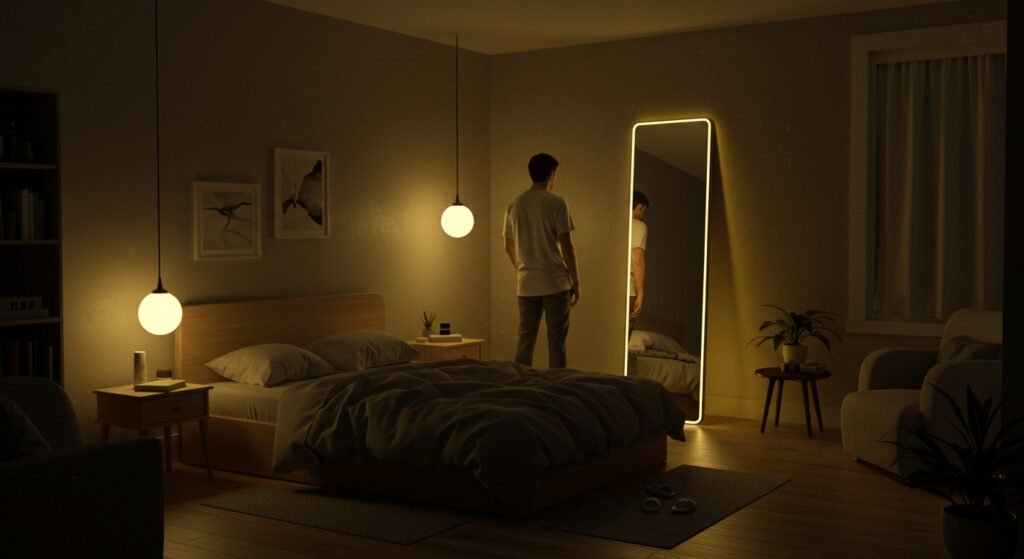
Should a Mirror Face a Window?
Mirrors and windows are a double-edged sword in bedroom design. They provide opportunities but also come with unique considerations related to light management and overall visual appeal. Placing mirrors to reflect windows can amplify natural light and help bring the outside in. Mirrors can also create stunning reflections of gardens, trees, or other outdoor views. But this placement can also create harsh glare when the sun is low on the horizon or amplify heat gain if positioned to reflect direct sunlight.
Consider how light conditions change throughout the day and what that means for functionality and comfort, especially when using an LED mirror installation opposite a window. Contohnya, morning sunlight reflected from a bathroom mirror positioned opposite east-facing windows might be fantastic for morning routines. Walau bagaimanapun, what if that same bright light, now reflected off the bathroom mirror, stood between you and a relaxing afternoon respite?
Professional designers often recommend using mirrors with lights on a wall opposite windows if you don’t get much natural light. The mirror reflects the light and brightens things up. A lighted mirror looks great, provides you the extra light you need, and easily makes a significant impact in the space. Juga, in a room with a fantastic view or unique architectural features, you could put the wall mirror with lights in a position to reflect back that incredible view or great architectural features.
But, there is a privacy concern when your bathroom vanity mirrors reflect out the window where people could see in. Some designers get around this by suggesting using lighted vanity mirrors over there in your bathroom area, but have it angled in such a way that you’re capturing the light that’s coming in the window, but you’re not directly reflecting back out the actual window. It has become trendy over the past few years to place an LED lighted mirror in a dressing area off the bathroom.
Is It OK to Sleep Near Mirror?
The topic of mirrors near sleep spaces remains a hotly debated topic between sleep specialists and design psychology professionals. In the sleep world, some experts would caution about having mirrors where you could see yourself when you are drowsy or half-asleep. I’ve read where a sleep psychologist suggested that could be disconcerting and could potentially disrupt your sleep because when you are half-awake or half-asleep, you’re not fully aware that it’s your own reflection.
For those sensitive to mirrors while sleeping, consider options like led bathroom mirror installations with dimming features that can be adjusted or turned off during sleep hours. Some interior designers recommend backlit mirror options that provide ambient lighting without strong reflection when sleep sensitivity is a concern. Research shows that mirrors in bedroom spaces positioned where they’re visible from the bed may contribute to increased dream recall and potentially more vivid dreams—positive for some individuals but disturbing for others.
Sleep psychologists suggest that if you experience unexplained sleep disturbances, evaluating mirror placement might be worthwhile, particularly focusing on bathroom light mirror positions that might reflect movement or light during rest periods. For those adhering to Feng Shui principles, any mirror in a bedroom should be positioned where it cannot reflect the sleeper, with particular caution around light up vanity mirror installations that combine reflection with illumination.
In the end, do what feels right for you. Some people sleep perfectly fine with lighted vanity mirrors over there in the bathroom as well.

A Guide to Mirror Placement in Your Home
Mirrors beyond the bedroom elevate every room when placed with balance that meets your functional needs and design goals. Place mirrors throughout a home to reflect beautiful views, magnify light sources, and create visual balance with adjacent features. Prioritize function—mirrors used for grooming need appropriate lighting, where mirrors used for decoration should highlight design elements.
In entries, mirrors offer a bright welcome and a final chance for a once-over before you head out the door. When installing bathroom mirrors, you center them over the sink. Countertop size dictates bathroom vanity mirror size. Mirrors in living areas help reflect both natural light and artificial light at strategic locations throughout the day.
In dining areas, position mirrors to reflect centerpieces or chandelier light, adding depth during meals or gatherings. Mirrors in kitchens should avoid reflecting cooking areas, or you’ll have double the visual clutter. Mirrors in hallways help the space feel wider and provide light in typically dark places. It’s a win/win.
Home offices benefit from mirrors positioned to reflect natural light sources without creating screen glare. When selecting modern lighted mirrors for bathrooms throughout the home, consider consistent styling for cohesive design flow. Remember that vanity mirror with led lights installations work beyond traditional bathroom settings—they function beautifully in home gyms, craft rooms, or anywhere detailed visibility matters.
Where Should I Position My Mirrors?
Good mirror placement follows basic principles that carry through different spaces, making a room look good and work better. Position a mirror where it reflects something beautiful—a window, artwork, or an architectural element. Think in terms of both sitting and standing views. Make sure there’s enough light for the mirror to do its job.
When installing led bathroom mirror units, position them where they receive balanced lighting from both natural and artificial sources to prevent unflattering shadows. The most successful mirror in bedroom ideas integrate the reflective surface with the room’s traffic patterns and daily routines.
For makeup application, lighted makeup mirror positioning should prioritize even facial illumination with minimal shadows. In a small space, you’d likely want to avoid looking at yourself sitting on the toilet. Similarly, in a tiny studio apartment, you wouldn’t place a large floor mirror opposite your bed with your pillows in view. Instead, you’d place it across from the door or at an angle in the corner.
For optimal impact, large wall mirror with lights installations should be positioned where they can be appreciated from primary seating or standing positions within the room. When using mirrors in bedroom designs for space enhancement, position them where they won’t be obscured by furniture or décor items that limit their reflective benefits. Professional installers recommend securing any mirror in a bedroom with appropriate mounting hardware rated for the specific mirror weight and wall type.
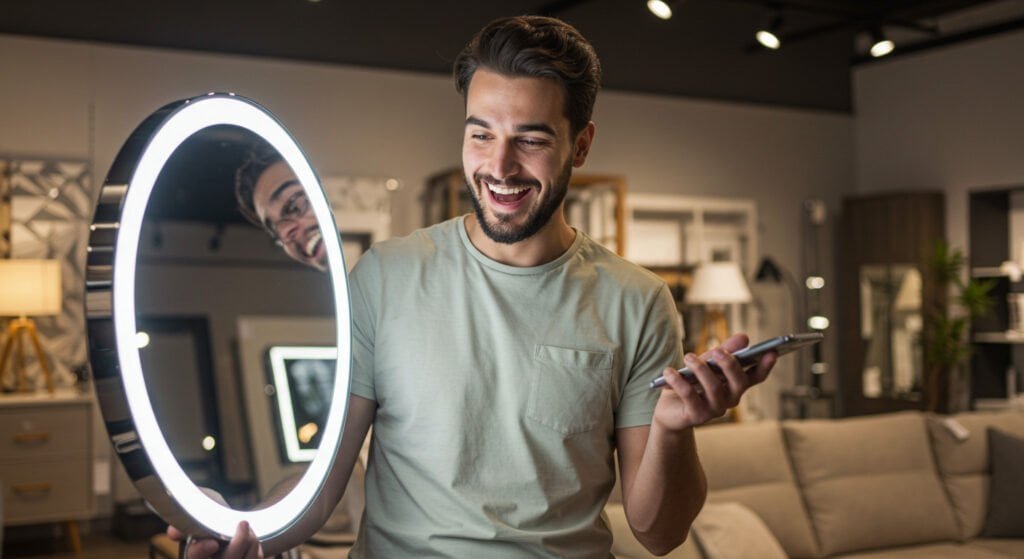
Which Wall Should Have a Mirror?
The selection of specific walls for mirror placement significantly impacts both the functional value and visual effect of the mirror in any space. Choose walls that will reflect the most attractive elements while serving practical needs. In bedrooms, primary mirror walls should typically be perpendicular to the bed rather than directly facing it, balancing visibility with restful energy.
Walls opposite windows make ideal locations for bathroom mirror installations, maximizing natural light reflection throughout the space. For bedrooms with architectural features like fireplaces or decorative moldings, position mirrors on adjacent walls to visually expand these elements.
LED bathroom mirror fixtures work particularly well on walls that receive minimal natural light, as their built-in illumination compensates for darker areas. When selecting walls for mirror in bedroom ideas, consider how the reflection will appear from different positions within the room. Avoid walls where a mirror might create uncomfortable sight lines or expose private areas to reflection.
For maximum visual impact, modern lighted mirrors for bathrooms often perform best on focal walls visible upon entering the room. When working with lighted vanity mirrors for bathroom areas within bedrooms, position them on walls that allow convenient access to electrical sources without extensive rewiring. Some designers recommend installing a backlit mirror on walls with texture or interesting paint treatments, as the illumination highlights these features beautifully. For custom glass mirror installations, walls free from obstructions like air vents or light switches provide the cleanest, most professional appearance.
Kesimpulan
Strategic mirror placement transforms bedroom functionality while enhancing design aesthetic. Consider both practical needs and energy principles when positioning any mirror, prioritizing peaceful sleep while maximizing light and space perception.
- Untuk mengetahui cara memilih cermin bilik mandi yang betul klik di sini.
- Untuk mengetahui cara memasang cermin pilih di sini.
- Untuk mengetahui cara memilih cermin saiz yang betul klik di sini.
- Untuk mengetahui bagaimana cermin dibuat klik di sini.
- Klik di sini dan anda akan mengetahui mengapa kami kelihatan lebih baik dalam cermin.
- Klik di sini anda akan mengetahui mengenai bahagian atas 10 pengeluar cermin LED untuk 2024.
- Klik di sini untuk mengetahui mengapa lampu cermin sia -sia saya tidak menyala?
- Ketahui berapa tinggi cermin bilik mandi?Klik di sini
- Klik di sini jika anda tidak tahu cara membersihkan cermin anda
- Untuk mengetahui cara membetulkan cermin sensor sentuh tidak berfungsi klik di sini





